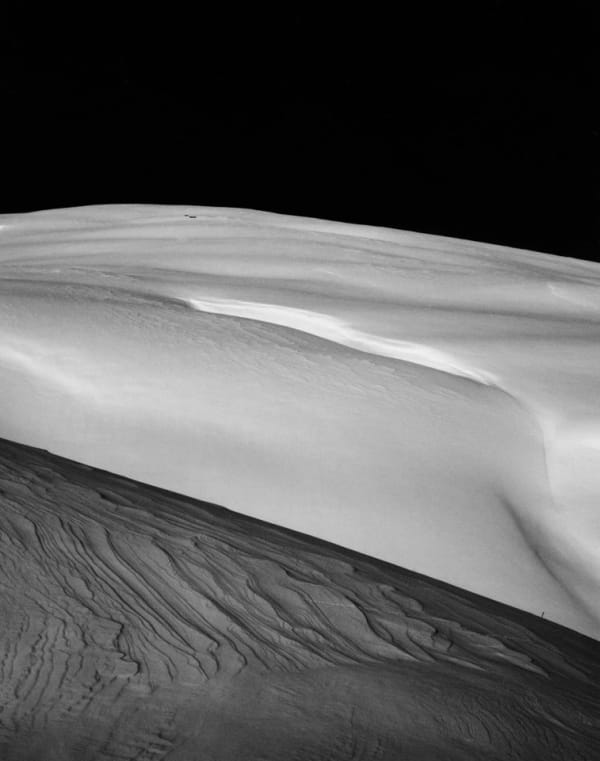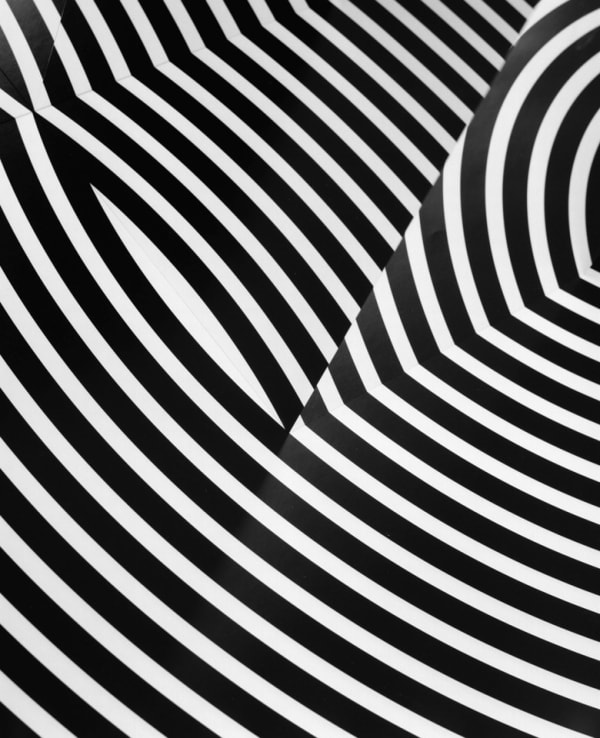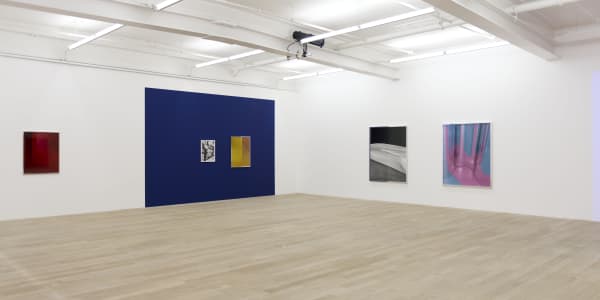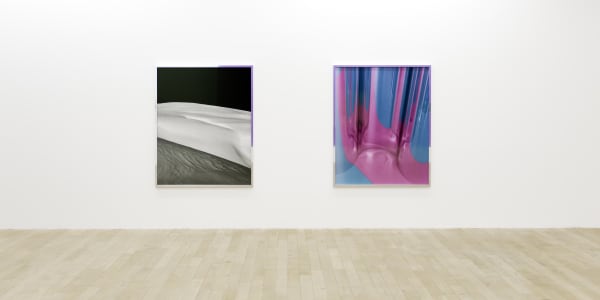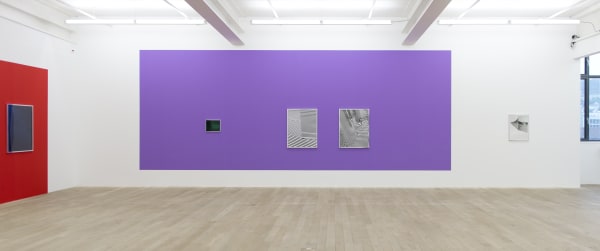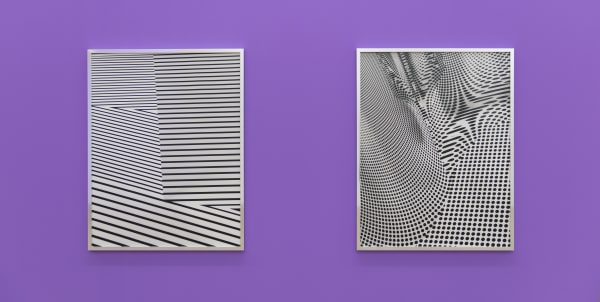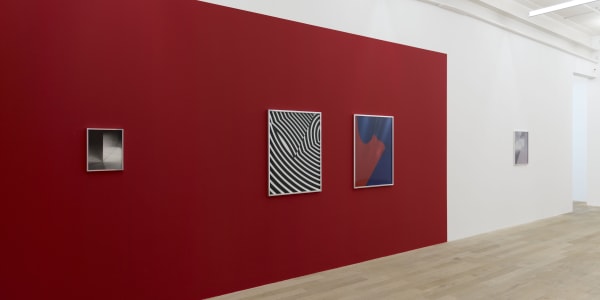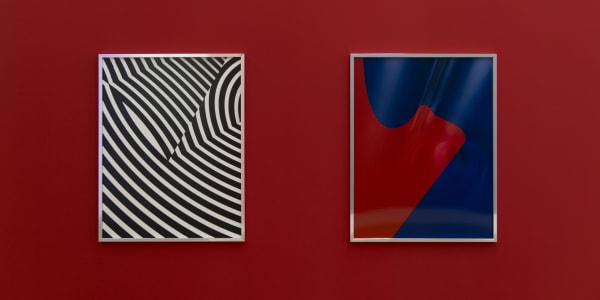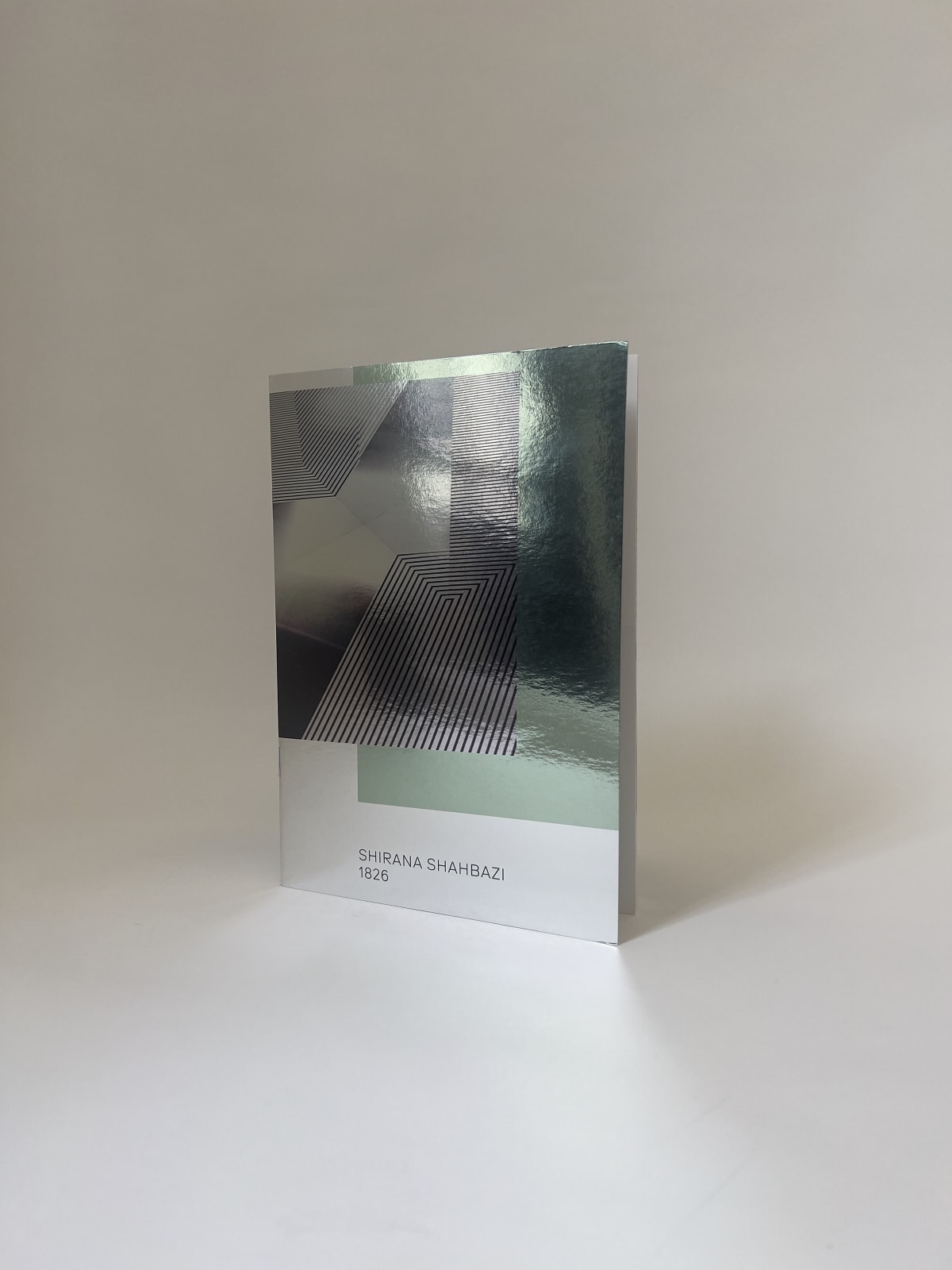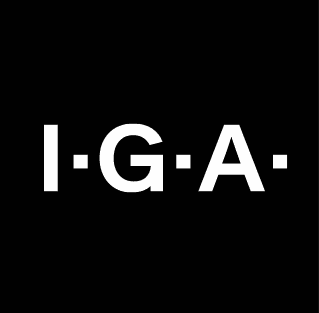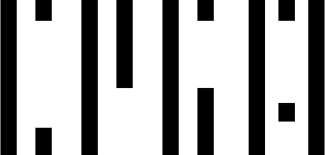Her practice is characterized by a substantial diversity of production processes that are able to co-exist simultaneously with intriguing naturalness. Shahbazi will present a new group of works that for the first time combines her different working methods to create an overall visual experience. On view are C-prints and lithographs that break the boundaries between abstraction and figuration, between photographic staging and the capturing of the fleeting moment, creating a coherent whole.
It is a pictorial world of intangible surfaces, textures, materials and objects that confronts the viewer with his own consciousness as well as with the perception of reality. In the works on view, we encounter primarily motifs, whether figurative elements or geometrical forms, that have been deliberately taken away from their narrative contexts. We come across scenes that move beyond abstraction: a girl walking, the close-up of a young woman - scenes that, out of habit, our eyes would want to categorize as records of social moments; but by trying to find out about the story behind, we are lead to a misleading discourse. Instead of deciphering a certain image, questions arise, such as why a motif appears twofold, cropped, or as if reflected by a merely discernible surface. Random everyday images like Mädchen laufend 01 (Girl walking) are suddenly integrated in the process of a precisely staged studio shot and appear not less abstract than the distorted irregularity of the edgy striped pattern in Raum-Streifen-01 (Room-Stripes-01) (see invitation card).
The principle can be likewise reversed: through constant alienation pictorial image spaces are created that make it difficult to distinguish between reality and illusion. We encounter a laminar, mat green composition, with its soft curves and curling edges drawing parallels to the moving structures of a landscape. Another work awakens thoughts of deep blue tidal waves, would the pale-shimmering of its foam not be interrupted by placative, pink-colored surfaces. Red and blue rigid longitudinal stripes are suddenly soft and rolling. Single image fragments appear to be arching three-dimensionally out of the pictorial plane or to be penetrating into it at an infinite depth. Color patterns that appear to be two-dimensional are given a haptic structure, and seem to be dissolved, deformed and segmented in unpredictable ways. Vigorous colors turn to simple black and white, are reduced, somehow misplaced. The result is a perceptual irritation that affronts but does not restraint. On the contrary, the viewer is encouraged to leave his usual point of view and approach the image on a new semantic level. These are image worlds that demand a longer discussion and open up thoughts.
Shahbazi determines with a painstakingly rigorous compositional approach, how the works are hung and displayed. In her conceptual practice an all-important medium is thus added to the medium of photography: the medium of the exhibition. For the exhibition in the galley parts of the walls have been painted in colors individually created by the artist: night blue, traffic red, silver gray and so on. The painted surfaces are complemented by a colored light intervention. Large-scale real color surfaces alternate with projected light surfaces, sensitizing the observer to a differentiated color perception. By hanging the geometric studio photographs on colored walls Shahbazi creates a situation that can either be viewed in its entirety from a distance, or by stepping closer and glancing back and forth. There are several things going on at once and the composition shifts from the image to the wall, and vice versa.
On view in the third room are black-and-white lithographs from the series "Tehran North" (2015-2017), whose point of departure is a stay by the artist in Tehran in October 2015. The series is like a subjective road movie captured from a car driving through the Iranian capital at night. It offers a black and white kaleidoscopic vision of Tehran's urban landscape. Although remote and unknown to many, Tehran comes across to be as common as any other city: housing areas, illuminated shops and billboards, highways and facades vanish either in darkness or in bright light, slipping away from any decisive representation. Uncanny encounters clash with everyday banality. The mysterious is at the same time forced and undermined, suppressing any exoticism.
Shahbazi's works are represented in the collections of major institutions worldwide such as the Museum of Modern Art, New York, Tate Modern, London, the National Museum of Photography, Copenhagen and the Migros Museum for Contemporary Art, Zurich. The KINDL Center for Contemporary Art, Berlin, is currently dedicating a retrospective to the artist entitled "first things first". In 2016 the Museum Camera Austria, Graz, presented the solo exhibition "Shirana Shahbazi: Groupshow". In 2015, in the context of the solo exhibition "MONSTERA" in the Kunsthalle Bern, Shahbazi's lithographic works were presented for the first time. In june 2017 she did a colorful overall installation in the exhibition space of PARKETT Editions in Zurich, including a selection of art works, that is open through October 23. On November 3 the Museum Fotogalleriet will open a major solo exhibition by the artist in Oslo, Norway. Since 2005 Shahbazi has been known for her art projects in public space. In 2015 she participated in the remodelling of a bank in Zurich (Zürcher Kantonalbank) and in 2017 she designed the walls of the offices of the new Zurich branch of the Axel Springer publishing house. The catalogues published on occasion of her solo shows at KINDL and Kunsthalle Bern are available in the gallery.
 Shirana ShahbaziRot-Pink-01, 2017C-print on aluminium150 x 120 cm (59.1 x 47.2 in.)
Shirana ShahbaziRot-Pink-01, 2017C-print on aluminium150 x 120 cm (59.1 x 47.2 in.) Shirana ShahbaziRaum-Gelb-01, 2017C-print on aluminium90 x 70 cm (35.4 x 27.6 in.)
Shirana ShahbaziRaum-Gelb-01, 2017C-print on aluminium90 x 70 cm (35.4 x 27.6 in.) Shirana ShahbaziMond, 2017Gelatin silver print on baryta paper on aluminium150 x 120 cm (59.1 x 47.2 in.)
Shirana ShahbaziMond, 2017Gelatin silver print on baryta paper on aluminium150 x 120 cm (59.1 x 47.2 in.) Shirana ShahbaziStreifen-Rot-Blau-Weiss-01, 2017C-print on aluminium90 x 70 cm (35.4 x 27.6 in.)
Shirana ShahbaziStreifen-Rot-Blau-Weiss-01, 2017C-print on aluminium90 x 70 cm (35.4 x 27.6 in.) Shirana ShahbaziGrün-Blau-01, 2017C-print on aluminium150 x 120 cm (59.1 x 47.2 in.)
Shirana ShahbaziGrün-Blau-01, 2017C-print on aluminium150 x 120 cm (59.1 x 47.2 in.) Shirana ShahbaziRaum-Rot-01, 2017C-print on aluminium90 x 70 cm (35.4 x 27.6 in.)
Shirana ShahbaziRaum-Rot-01, 2017C-print on aluminium90 x 70 cm (35.4 x 27.6 in.) Shirana ShahbaziBaum, 2017Lithography on Zerkall Bütten Paper60 x 45 cm (23.6 x 17.7 in.)
Shirana ShahbaziBaum, 2017Lithography on Zerkall Bütten Paper60 x 45 cm (23.6 x 17.7 in.) Shirana ShahbaziMuster-03, 2017C-print on aluminium90 x 70 cm (35.4 x 27.6 in.)
Shirana ShahbaziMuster-03, 2017C-print on aluminium90 x 70 cm (35.4 x 27.6 in.) Shirana ShahbaziRaum Wüste, 2017Lithography on Zerkall Bütten Paper60 x 45 cm (23.6 x 17.7 in.)
Shirana ShahbaziRaum Wüste, 2017Lithography on Zerkall Bütten Paper60 x 45 cm (23.6 x 17.7 in.) Shirana ShahbaziTehran North, 2015-2017Series of 44 lithography prints on Bütten Paper
Shirana ShahbaziTehran North, 2015-2017Series of 44 lithography prints on Bütten Paper


